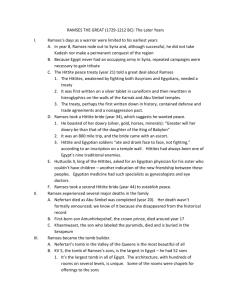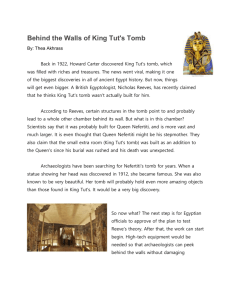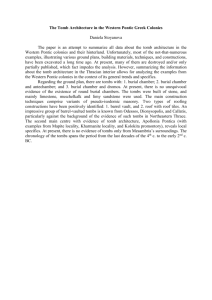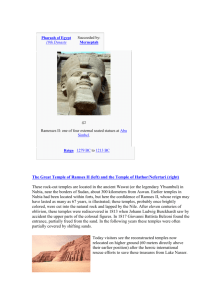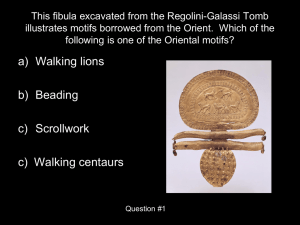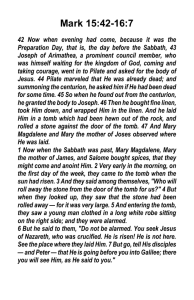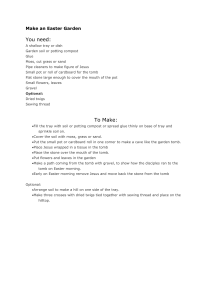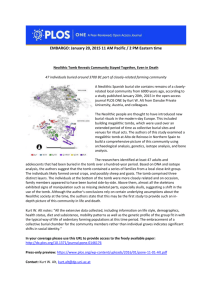Valley of the Queens
advertisement
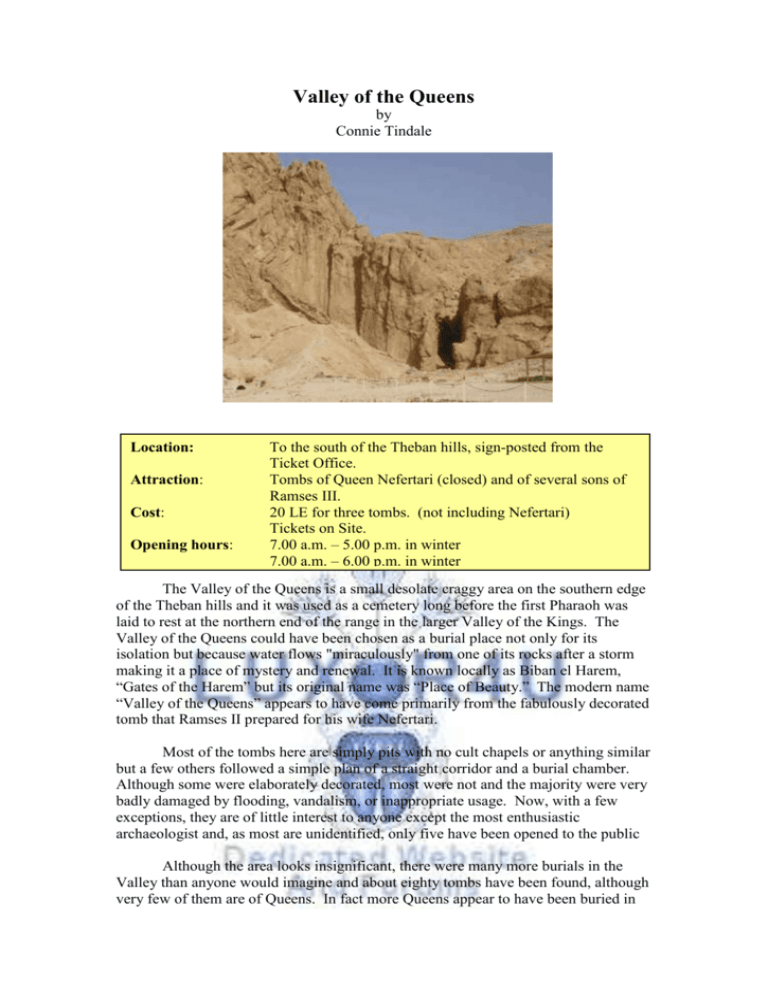
Valley of the Queens by Connie Tindale Location: Attraction: Cost: Opening hours: To the south of the Theban hills, sign-posted from the Ticket Office. Tombs of Queen Nefertari (closed) and of several sons of Ramses III. 20 LE for three tombs. (not including Nefertari) Tickets on Site. 7.00 a.m. – 5.00 p.m. in winter 7.00 a.m. – 6.00 p.m. in winter The Valley of the Queens is a small desolate craggy area on the southern edge of the Theban hills and it was used as a cemetery long before the first Pharaoh was laid to rest at the northern end of the range in the larger Valley of the Kings. The Valley of the Queens could have been chosen as a burial place not only for its isolation but because water flows "miraculously" from one of its rocks after a storm making it a place of mystery and renewal. It is known locally as Biban el Harem, “Gates of the Harem” but its original name was “Place of Beauty.” The modern name “Valley of the Queens” appears to have come primarily from the fabulously decorated tomb that Ramses II prepared for his wife Nefertari. Most of the tombs here are simply pits with no cult chapels or anything similar but a few others followed a simple plan of a straight corridor and a burial chamber. Although some were elaborately decorated, most were not and the majority were very badly damaged by flooding, vandalism, or inappropriate usage. Now, with a few exceptions, they are of little interest to anyone except the most enthusiastic archaeologist and, as most are unidentified, only five have been opened to the public Although the area looks insignificant, there were many more burials in the Valley than anyone would imagine and about eighty tombs have been found, although very few of them are of Queens. In fact more Queens appear to have been buried in the 'lost cemetery' that Carter located above the Valley of the Kings than are buried in this Valley. Most of the tombs here are of Princes and others could be of Priests who adopted Royal titles during the breakdown in government control in the later part of the 20th dynasty. Among the tombs whose owners are known are those of: Queen Sit-re the wife of Ramses I, Queen Tuy the wife of Seti I, Queen Nefertari and six daughter/wives of Ramses II. Also buried there are two wives of Ramses III, five of his sons and several viziers of Tutmosis I. Family relationships in Egypt’s monarchy are often too complex to decipher, due to the incestuous marriages that occurred between brothers and sisters, and fathers and daughters. Ramses II is alleged to have been, at the same time, both father and husband to some mothers of his children, to whom he was both father and grandfather. Although he buried his daughter/ wives in the Valley of the Queens, he chose to inter many of his sons in a communal tomb (KV5) in the Valley of the Kings Workers from the Deir-el-Medina probably constructed the later tombs in the Valley of the Queens. The remains of rest houses similar to those above the Valley of the Kings have been found. As the group of rest houses is small, it is unlikely that this would have been a separate settlement. For visitors, the big draw to the Valley of the Queens was the tomb of Nefertari, which was beautifully restored at great cost a few years ago, but the tomb was closed again recently because even severely restricted visitor numbers proved too damaging to its fabric. Nobody knows when or if the tomb will re-open. Those of us who have seen the inside of this tomb consider ourselves privileged despite paying 100 LE for a ten-minute stay. When and if the tomb re-opens, the entrance fee is likely to be more than double that amount. There are not many visitors to the Valley of the Queens now that Nefertari’s tomb is closed so it is never crowded and, apart from the build up of heat in the middle of the day, the valley can be visited at any time. The ticket covers entrance to any three tombs but when I visited, only three tombs were open so it negated any predicament over which one to omit. Tomb of Queen Nefertari (QV 66) Temporarily closed Tomb of Queen Nefertari – the four sons of Horus. When Ernesto Schiaparelli discovered this tomb in 1904, all the paintings on its walls were in pristine condition but by the 1980’s they had deteriorated alarmingly. Salt crystals, caused by humidity and rising groundwater levels, had caused the plaster to flake away, ruining the magnificent paintings in the process. In order to stop the deterioration, a major five-year restoration project was undertaken at a cost of around $5 million and the deterioration was halted. The tomb was then reopened to the public with severely restricted visitor numbers but the tomb was closed yet again for restoration in 2004 and has yet to be re-opened. This tomb is perhaps the most beautiful and is certainly the most colourful of all the Theban tombs. It shows the love and respect that Ramses II had for his favourite wife. Nefertari was not his only Great Royal Wife, as his reign was long, and after she died his principal daughters ascended to her position. However, no other wife had the same influence on state affairs that she did and she held the title “Lady of the Two Lands” referring to her importance to Upper and Lower Egypt. In addition to this glorious tomb Ramses dedicated the temple of Hathor at Abu Simbel to her, the only queen to be given such an honour. Above left: Above right: Nefertari presents offerings to Isis Anubis is stretched out on a tomb waiting to greet Nefertari. Beyond the entrance to the tomb is a sloping corridor, which represents the descent into the underworld. It is beautifully decorated with aspects of Nefertari with Isis and Nephthys, predominantly in scarlet, black, and gold - a truly stunning combination of colours. Her burial chamber has four supporting pillars, with two side rooms and a small inner room accessed from it. The four pillars, which are decorated with a variety of deities, formed a shrine for the sarcophagus, which unfortunately has never been found. Inside, the chamber the god Anubis is stretched out on a tomb waiting to greet Nefertari as she continues her journeys into the underworld where Isis takes her by the hand to greet Osiris who will open her mouth and breath new life into her. To ensure her safe passage through the underworld Nefertari pays homage to the Books of Gates, which are depicted on the tomb walls. Above left Above right: Isis takes Nefertari by the hand to lead her to Osiris Osiris waits for Nefertari in the Underworld Ramses II was lax in the quality of some if the work in his monuments and in the placement of his own tomb, but the craftsmanship in this tomb is superb and I am of mixed feelings as to whether I think the tomb should be reopened to the public. To deprive people of the thrill of seeing this tomb is a tragedy; to see it deteriorate even further is an even greater one. Queen Tyti (QV 52) Queen Tyti could have been one of the wives of Ramses III and her tomb is large enough to warrant such a position but although she is referred to in various places as “Chief Royal Wife” and “King’s daughter” her exact position is not mentioned. As she is also referred to as “King’s mother” and “King’s sister” there could be great speculation over her relationships. She could also have been the mother of Princes Amun-her-Khepshef and Khaemwaset, two sons of Ramses III that lie close to her in the Valley of the Queens. But, of course, this again is uncertain as she could just as well have been one of the wives of a much later Ramesside king. The paintings on the walls of this cruciform tomb were once splendid but they have faded or been damaged by time so are less impressive than they deserve to be. In brief, in the main corridor Queen Tyti is shown before Thoth and the four sons of Horus guard the burial chamber. There are three side chambers off the main burial chamber, one of which has paintings of Hathor. The burial chamber itself has jackal and baboon paintings. Above left: Above right: the four sons of Horus guard the burial chamber of Queen Tyti Horus, Thoth and Anubis wait to greet Tyti. Prince Khaemwaset (QV 44) Like many of the tombs in the Valley, this tomb follows a straight axis with a sloping corridor that leads to a long antechamber which annexes run on either side. Beyond this is the burial chamber, which has niches and a further annex at the rear. Ramses III emulated Ramses II in many ways and he named several of his own sons after those of Ramses II. The original Prince Khaemwaset was one of the more famous sons of Ramses II as he became High Priest of Ptah but this Prince Khaemwaset although he also became a priest of Ptah did not rise to the same heights as his namesake. Nevertheless, he did hold high office and in his youth was ‘fanbearer to the right of the King’. He was one of Ramses III older sons and it is thought that Queen Tyti may have been his mother but his age at death has never been determined. Above; Prince Khaemwaset s presented to the gods by his father Ramses III Many of the tomb’s paintings show him with the side-lock of a child but markings on his sarcophagus indicate that he might have outlived his father. However, this seems unlikely as there would have been evidence of him holding higher office than he did. Also, most of the tomb’s paintings are of Ramses III presenting his son to the Gods and if Ramses were already dead, then this would not have been possible. It is therefore safe to assume that although he did not die in infancy he probably did die before his father and that could be why a fifth son rather than him ascended to the throne. Also, the sarcophagus could have been one that had been recycled. The tomb has elegant paintings throughout and several chapters of the Book of the Dead are shown on the burial chamber walls together with illustrations of Ramses III taking Prince Khaemwaset through the various Gates that lead to the Underworld and hence to the realm of Osiris. On the rear wall of the burial chamber annex is a painting of Osiris with green skin between the goddesses Neith and Nephthys while at his feet, the four sons of Horus rise from a lotus flower. Prince Amun-her-Khopshef (QV55) Ernesto Schiapaelli discovered this tomb during the Italian expedition’s second diggings in the Valley 1903. Although, like many other tombs it had been looted probably not long after its completion, its structure and decorations were in good condition. The basic shape of the tomb is similar to that of Prince Khaemwaset, a straight corridor leading first to an antechamber and then to the burial chamber. There are single annexes leading from both rooms. The main theme of the tomb paintings is Ramses III introducing his son to various gods and there are some fine paintings of him wearing a serpent crown. Amun-her-Khepshef is shown with his hair in a side lock, like that shown below, which was a style worn by children. From this, we can assume that he, like many of his brothers, died in childhood and although estimates of his age at death vary, it is likely that it occurred when he was around fifteen years old. Left: Tomb image of Prince Amun-her-Khepshef Above: Tomb image of his father, Ramses III. He was not one of Ramses III senior sons but he did hold many titles and is shown both in his tomb and in the Medinet Habu as being a fan-bearer on the righthand side of his father, which was a position of importance that several of his brothers held. At the rear of this tomb is a case which holds a mummified foetus that myth ascribed to a miscarriage his mother (possibly Queen Tyti) had on hearing the news of his death. This is an interesting tale but that is all it is because later studies have discovered that the foetus was moved there from another tomb early in the 20th Century. Alternative spellings: Queen Tyti = Queen Titi Prince Khaemwaset = Khaemweset Amun-her-Khopshef = Amunhirkhopsef, Amunherkhopsef Ramses III – Ramesses III, Rameses III Significant Tombs in the Valley of the Queens QV 30 Nebiri (probably), Head of the Stable, Dynasty XVIII QV 31 A Queen QV 33 Princess Tanezem(t) Dynasty XX (?) QV 36 Princess, no name QV 37 Queen Si-tre wife of Ramses I QV 40 Anonymous Princess or Queen QV 42 Prince Para'hirwenemef, son of Ramesses III QV 43 Prince Set-hir-khopshef, King's son, Son of Ramses III QV 44 Prince Khaemwaset, Sem- priest of Ptah. Son of Ramesses III QV46 . QV 47 Imhotep (probably) Vizier. Tuthmosis I QV.51 Queen Esi II mother of Ramses VI, daughter of Hubalznet: QV 52 Queen Tyti – possible wife of Ramses III QV 53 Prince Ramses son of Ramses III QV 55 Prince Amen-hir-khopshef Royal Scribe, son of Ramses III QV 60 Queen Nebttaui daughter of Ramses II QV 66 Queen Nefertari Wife of Ramses II QV.68 Queen Merytamun daughter of Ramses II QV 71 Queen Bent'anta daughter of Ramses II QV 73 A Princess, no name. Dynasty XX QV 74 Queen Tentopet Great King's mother and King's wife QV 75 A Queen, no name QV 80 Queen Tuy – wife of Seti I QV 88 Prince Ahmose Princess 'Ahmosi Daughter of Sekenenre'-Ta'a and Sit-dhout:

